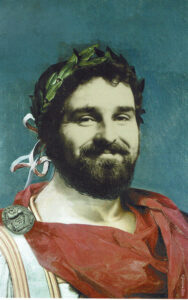
When I first came to Warsaw, I contacted Professor Aleksander Bursche, whom I had met at the International Numismatic Congress in Taormina. I hoped to get some tips from him as to which museums had interesting numismatic collections and which colleagues I needed to ask to get access. What happened next was something I had never experienced before: A red carpet was laid out in front of me. Polish colleagues whom I had never heard of before sent me emails asking when I would like to visit them; guided tours were offered to me; doors opened. Aleksander Bursche’s recommendation was the perfect entrance ticket to Poland’s numismatic world.
I was deeply moved by the respect and the love with which all the Polish colleagues referred to Aleksander Bursche. They were very lucky to have a teacher who, in addition to imparting knowledge, made it his mission to promote every able and dedicated student (male or female alike) during and also after their studies – it is telling that two of his female students, Roksana Chowaniec and Renata Ciołek, edited this Festschrift. The volume, which was jointly published by his students, friends and colleagues for his 65th birthday, demonstrates how much those who were supported by him appreciate his help. The work gives a small insight into the many fields on which the honoured has had a lasting impact.
Archaeologist, Numismatist, Historian and Specialist for the “Barbaricum”
The German prehistorian Claus von Carnap-Bornheim, who delivers an excellent characterization of Aleksander Bursche in his eulogy, is not quite sure “whether Aleksander thinks of himself as an archaeologist or a numismatician. It seems to change depending on the time of day – or even better – on the archaeological or numismatic work at hand. However, what seems really important, is the organic complementarity between these two scholarly disciplines. He sees a blend of archaeology, numismatics, and ancient history as a logical consequence and methodological necessity whenever a holistic investigation is the goal, especially regarding the European Barbaricum in the 1st centuries AD.” This is an excellent summary of what is so special about Aleksander Bursche’s scholarly work. He stands for crossing borders – between disciplines, countries, languages.
And this is reflected by his Festschrift. It contains a wealth of papers written by renowned scholars and friends, who do not only live in Poland but all over the world. The articles are arranged in alphabetical order, according to the author’s surname – without any vita to tell the reader about the author’s position in the scholarly world. This comes with advantages and disadvantages. The advantage: you have to read the papers in order to make up your mind about the importance of their content. The disadvantage: you have to read the papers in order to see if they are of interest to the field you work in. Even though most articles are dedicated to the “Barbaricum”, other areas are dealt with as well, such as coinage before, during and after the Roman rule, and (mostly) Polish archaeology and methodology. And of course special fields like papyrology.
Focus “Barbaricum”
The main focus is of course on the Migration Period and the peoples involved in it. Many papers deal with the so-called “Barbaricum”. And if today’s authors find it difficult to describe the cultures north of the Roman Limes as “Barbaricum”, as ancient writers did, this is also due to the publications on these cultures by Aleksander Bursche and his students.
That is why this Festschrift is an absolute “must” for anyone interested in these peoples and the migration period. Numismatists in particular will find it very insightful, especially if you are interested in “barbarian” imitations.
However, you have to be aware that most papers are rather short – they have an average of less than 10 pages – and are meant to be contributions to current research. But there is also something for those who see a numismatic book’s value solely in the fact that it helps them identify coins: Wolfgang Fischer-Bossert contributed a very useful catalogue of the Celtic drachms of Asia Minor, and Ute Wartenberg presents a hoard find of the rare obols of Aegina, which was buried around 500 BC.
A great Festschrift is more than a compilation of papers. It accounts for the scholarly importance of a jubilee. The Aleksanderia succeeded in this task, and it is even more: the volume depicts a true-to-life image of Aleksander Bursche and reflects the affectionate respect felt by many for his straightforward personality. How else could the author of this review explain that Bursche’s picture published in the Aleksanderia is not a usual portrait taken by a photographer but the photo montage of a smiling patriarch in the dress of a Roman emperor?
Happy birthday, dear Aleksander! Plurimos Annos!
The Festschrift can be purchased as a hardcover version or as an ebook from the Harassowitz Verlag.


